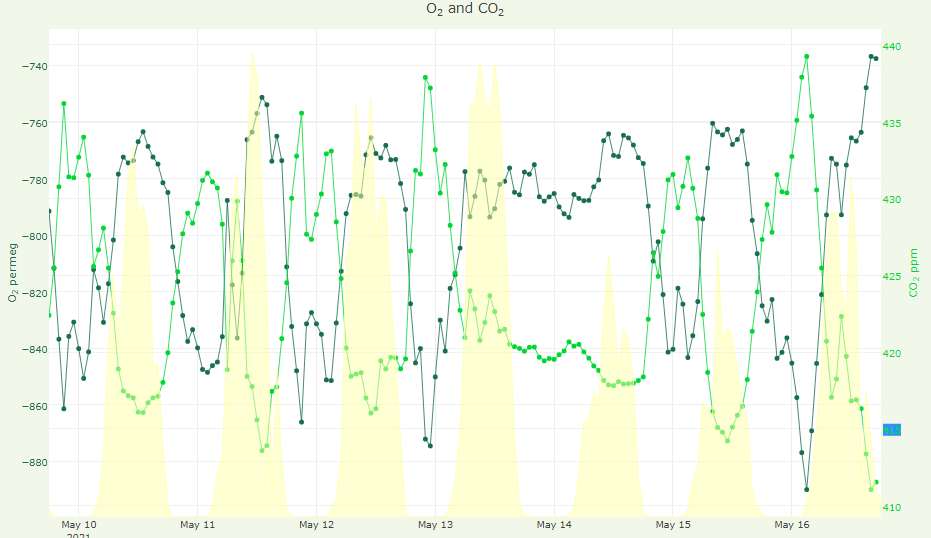The video below is a virtual tour of the University of East Anglia’s Greenhouse Gas Observatory at Weybourne on the north Norfolk coast. Since 2008 we’ve been continuously measuring atmospheric concentrations of carbon dioxide, oxygen, and carbon monoxide. It’s measurements like these that allow scientists to monitor changes in the greenhouse effect due to human emissions of greenhouse gases. The longest continuous record of atmospheric carbon dioxide concentration is taken from the Mauna Loa Observatory in Hawaii and dates back to 1958.
Data Exploration
You can explore the latest data on atmospheric gases from the Weybourne Atmospheric Observatory here. The graph below shows concentrations of atmospheric oxygen (dark green, left y-axis) and carbon dioxide (light green, right y-axis) over a weeklong period. The yellow peaks show periods of sunlight. Explore some of the trends with your class.

Discussion Points
What do you notice about the relationship between carbon dioxide and oxygen?
Carbon dioxide and oxygen express inverse relationships. When carbon dioxide increases, oxygen decreases. This is because they are controlled by similar processes. Carbon dioxide is consumed during plant photosynthesis and oxygen produced. Respiration consumes oxygen but produces carbon dioxide.
What do you notice about the time of day that each gas increases/decreases in concentration?
Carbon dioxide concentrations decrease during daylight hours. Oxygen concentrations increase during daylight hours. This is because photosynthesis dominates during the day as plants make use of sunlight. Photosynthesis absorbs carbon dioxide during the day and you can see the atmospheric concentration slowly declining.
At night, when there’s no light, photosynthesis stops, and respiration dominates. Respiration consumes oxygen and produces carbon dioxide. Hence we see the atmospheric concentration of carbon dioxide start to increase and oxygen decrease.
Curriculum Links
- The carbon cycle
- The composition of the atmosphere
- The production of carbon dioxide by human activity and the impact on climate
- The reactants in, and products of, photosynthesis, and a word summary for photosynthesis
- Common atmospheric pollutants: sulphur dioxide, oxides of nitrogen, particulates and their sources
- Evidence, and uncertainties in evidence, for additional anthropogenic causes of climate change
- Potential effects of, and mitigation of, increased levels of carbon dioxide and methane on the Earth’s climate
- Common atmospheric pollutants: sulphur dioxide, oxides of nitrogen, particulates and their sources